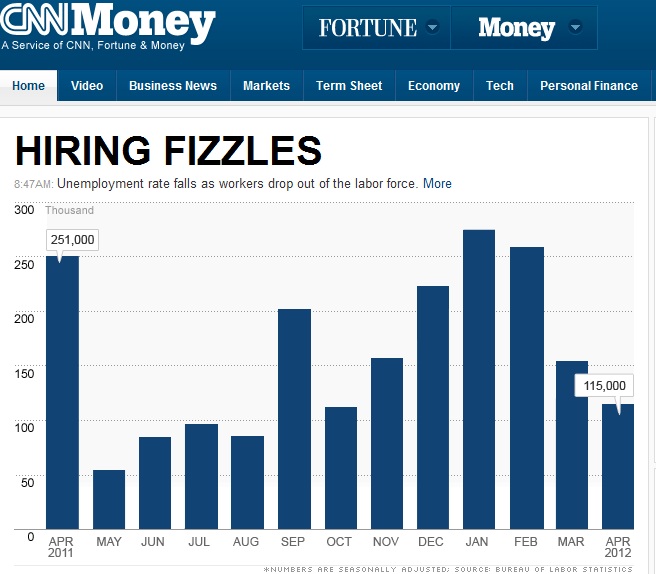Unemployment Rate Drops Because 522,000 Give Up Jobs Search
About 45,000 fewer jobs were added in April than economists expected,
and the unemployment rate dropped to 8.1 percent due to more than a
half million people giving up the job search. CNN Money reacted with the
headline “hiring fizzles.”
University
of Maryland Economist Peter Morici wrote in response the jobs report,
“The economy added 115,000 jobs in April - much less than expected and
not enough to keep up with natural population growth. The unemployment
rate fell to 8.1 percent because another 522,000 adults quit looking for
work and are no longer counted.”
According
to AEI’s James Pethokoukis the labor force participation rate is at the
lowest level since 1981, and if it “had stayed the same as in March,
unemployment rate would have risen to 8.4%” he tweeted.
Two days before the April jobs report was released, CNN Money published an article on “The 86 million invisible unemployed,”
complete with a graphic depicting Americans not in the labor force by
age group. According to that story, roughly 36 million of them are over
20-something and under age 65 and “The truth is, the Labor Department
simply doesn't know why they're not in the labor force.”
The Bureau of Labor Statistics released the April report
on May 4 showing 115,000 jobs added and an 8.1 percent unemployment
rate. It was the second disappointing jobs report in a row from the BLS.
Following
the March jobs report which showed only 120,000 jobs gained, a huge
disappointment when 200,000 were forecast, the media coverage was filled
with spin especially on MSNBC.
One
of the arguments made by a number of media outlets, including MSNBC,
was that a single month with a bad jobs report is not important as the
trend, and the trend is good. Will they still be able to say that after
April’s disappointing report?
During
Martin Bashir’s April 6 program the picture on the screen said
“Upswing” with picture of people in suits. Bashir interviewed journalist
and author William Cohan who said this month’s data was a “pothole” and
that one month is less important than the trend.
“The
last three months we’ve created an average of 212,000 jobs a month,
which is pretty darn good, and the overall rate of unemployment has come
down to about 8.2 -- some people have said, ‘well, that’s because
people have stopped looking for jobs’ -- but look, I think we’re on a
very solid trend now. As you said, 4 million new jobs in four years,
that’s something to be pretty proud of,” Cohan said. But neither Bashir,
nor Cohan pointed out that since February 2009 there has still been a
net loss of 740,000 jobs. And the Obama administration has fallen far
from keeping its jobs promises.
Democratic
strategist Krystal Ball also argued during an interview on “Jansing
& Co.” that day that the March report could be an aberration, and
might be revised upward. While the April data casts some doubt on her
“aberration” theory, there were positive revisions in the April report:
+19,000 for February and +34,000 for March.
Economist Nigel Gault of IHS Global Insight told Reuters that day, “I think that numbers will be better in the coming months.” While Caroline Baum of Bloomberg News claimed there is little difference between 120,000 and 220,000 jobs … “In a labor force of about 155 million, 100,000 is a rounding error.” Time magazine’s Adam Sorenson also spun the March report with the claim of “statistical noise.”




